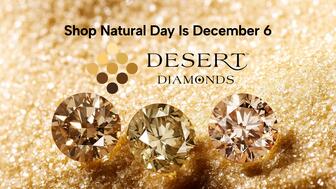Set in a Tiffany & Co. necklace, it sold for $4.2 million, the highest price and price per carat paid for a Paraíba tourmaline at auction.
Squirrel Spotting: Body Language Speaks Volumes
A great deal of time is spent coaching the correct language for sales. But even more important, Peter Smith says, is what your body language is saying.

A great deal of time and energy is spent by managers and trainers coaching the correct language to use in sales environments. We understand the power of words, and we must frequently battle the need to say just the right thing without it coming across as staged or contrived.
Some of the efforts are trite, outdated and wholly ineffective. “How can I help you?” ought to be unceremoniously retired because it all too often serves to invite the equally useless and generally automatic, “I’m just looking.”
Other greetings, such as DSW’s laughable, “May I help the next shoe-lover?” are borderline ridiculous, coming, no doubt, from a well-intentioned, but misguided, corporate head who likely never worked a day of his or her life behind a retail counter.
What we hear less of is the impact that good (or bad) body language can have on our customer interactions.
Connie Dieken wrote in “Talk Less, Say More” that, “Vision is the most dominant human sense. Your brain processes visuals up to 10 times faster than mere words, according to research in both educational theory and cognitive psychology.”
If Dieken is correct and we do, in fact, process visuals 10 times faster than words, it would seem to suggest that how we approach/engage customers and how we carry ourselves, physically, matters a good deal more than the words we use. And, as it happens, those non-verbal communications happen immediately and carry through the entirety of the customer interaction.
So, what are the most important elements of body language of which we ought to be aware?
In the first instance, we should know that “emotional contagion” is a term that psychologists like to use. What it really means is that whatever emotional state you bring in to an interaction will be contagious. If you approach your customers with good energy and a positive attitude, you will likely receive that positive energy in return.
On the other hand, a negative attitude and demeanor is likely to receive the same in response from your customer; a certain recipe for emotional disconnect. So, start with a positive attitude and good energy.
Alexander Todorov, Princeton University, wrote an important white paper that indicated that we make a decision about whether we like someone or not in one-tenth of a second. That kind of immediate non-verbal communication demands that our body language--typically observed before any words are ever spoken--is extremely important.
Smile
There is no better way to communicate non-verbally than to wear a smile on your face. Gretchen Rubin wrote in “The Happiness Project” that: “Studies show that you tend to like people whom you think like you; and the amount of time you smile during a conversation has a direct effect on how friendly you’re perceived to be.”
Touch
Leonard Mlodinow wrote in “Subliminal, How Your Unconscious Mind Rules Your Behavior” that: “Scientists have discovered a particular kind of nerve fiber in the people’s skin--especially in the face and arms--that appears to have developed specifically to transmit the pleasantness of social touch.”
The easiest way to physically connect with someone when you meet them is to extend your hand and introduce yourself. Sincerely touching their elbow or arm, as the conversation progresses, is another way to create a meaningful physical connection.
Look Into Their Eyes
Sanjida O’Connell wrote in “Mindreading, An Investigation into How We Learn to Love and Lie” that: “When someone stares directly into your eyes, your heart rate increases, as does the electrical activity in your brain.”
So, go ahead, make purposeful eye contact and use that electricity to light a spark.
Use Hand Gestures
Joe Navarro wrote in “What Every Body Is Saying” that: “Effective communicators use their hands as part of their speech.”
Pull up a few TED Talks and watch the top speakers communicate. They seem almost unable to speak without using their hands, and their communication is all the more effective for it.
Mirror the Customer’s Tone of Voice
Rosabeth Moss Kanter wrote in “Confidence” that: “The synchronizing of a sad or happy tone of voice, for example, is often unconscious, as though the human brain is hard-wired to get in tune with other people, because it is more pleasant to have a sense of rapport. Being out of tune is jarring and makes people feel isolated.”
Be Expansive and Open
In “Presence,” Amy Cuddy wrote, “When our body language is confident and open, other people respond in kind, unconsciously reinforcing not only their perceptions of us but also our perception of others.”
Encountering people who are closed to us, slightly turned (disconnected) or with folded arms (guarded) makes it very difficult to establish a rapport.
Active Listening
In “The Rare Find,” George Anders wrote, “Aggressive listeners gain authority by being incredibly attentive to other people. These experts catch the gestures, pauses and inflections that hint at something beyond the words being said at the time.”
There is, of course, a difference between listening and active listening. Active listening is, absent the verbals, a participatory activity. It requires much more than simply being quiet while the other person speaks. The listener should lean-in, nod in affirmation, maintain eye contact and generally mirror the facial expressions of the person speaking.
Being aware of our non-verbal communication is crucial to establishing and maintaining an emotional connection with our customers and our co-workers.
It has often been said that when the words being spoken are at odds with the body language, always believe the body language. It’s that important.
Peter Smith is president of Vibhor, a public speaker and author of “Sell Something” and “Hiring Squirrels.” He spent 30 years building sales teams in retail and wholesale and he can be contacted at dublinsmith@yahoo.com, peter@vibhorgems.com, or on LinkedIn, Facebook or Twitter.
The Latest

The jeweler’s “Deep Freeze” display showcases its iconic jewelry designs frozen in a vintage icebox.

Take luxury gifting to new heights this holiday season with the jeweler’s showstopping 12-carat sphene ring.

How Jewelers of America’s 20 Under 40 are leading to ensure a brighter future for the jewelry industry.

This year's theme is “Unveiling the Depths of the Ocean.”


In its annual report, Pinterest noted an increase in searches for brooches, heirloom jewelry, and ‘80s luxury.

Starting Jan. 1, customers can request the service for opal, peridot, and demantoid garnet.

Roseco’s 704-page catalog showcases new lab-grown diamonds, findings, tools & more—available in print or interactive digital editions.

The new catalog features its most popular chains as well as new styles.

The filmmaker’s personal F.P. Journe “FFC” prototype was the star of Phillips’ recent record-setting watch auction in New York.

The new location in the Design District pays homage to Miami’s Art Deco heritage and its connection to the ocean.

Inflations, tariffs, and politics—including the government shutdown—were among consumers’ top concerns last month.

“Longtime favorite” presenters, as well as first-time speakers, will lead talks and workshops at the annual event in Tucson next year.

Silas Smith of Meridian Metalworks won the challenge with his pendant that blends Australian and American landscapes.

The sale of the 31.68-carat, sunset-hued stone was part of Sotheby’s first series of events and auctions in Abu Dhabi.

Most customers who walk into your store this month have made up their minds. Your job is to validate their choice, Emmanuel Raheb writes.

The collection features characters and motifs from Ukrainian folklore, including an enchanted mirror and a magic egg.

MatrixGold 3.11, the newest version of the jewelry design program, offers more flexibility, precision, and creative control.

The pavilion will be part of the 2026 JA New York Spring show, scheduled for March 15 to 17.

Kadet, a 1994 National Jeweler Retailer Hall of Fame inductee, helped grow the family-owned retailer in the Chicago area and beyond.

Billed as the world’s smallest wearable, Lumia Health’s new smart earrings have a health tracker subtly embedded in the back.

Don’t let those with December birthdays feel blue. Help them celebrate their month with blue zircon, turquoise, and tanzanite.

The new pink sapphire version of the piece dances with its wearer in the brand’s “Icons After Dark” holiday campaign.

A choice that’s generated a lot of commentary, Pantone says “Cloud Dancer” marks a fresh start and encourages relaxation and creativity.

The manufacturer’s holiday campaign features a gift guide filled with trending designs and jewelry that can be personalized.

The man was charged with theft, accused of ingesting the necklace while in a jewelry store in Auckland, New Zealand.

Sponsored by De Beers Group



























